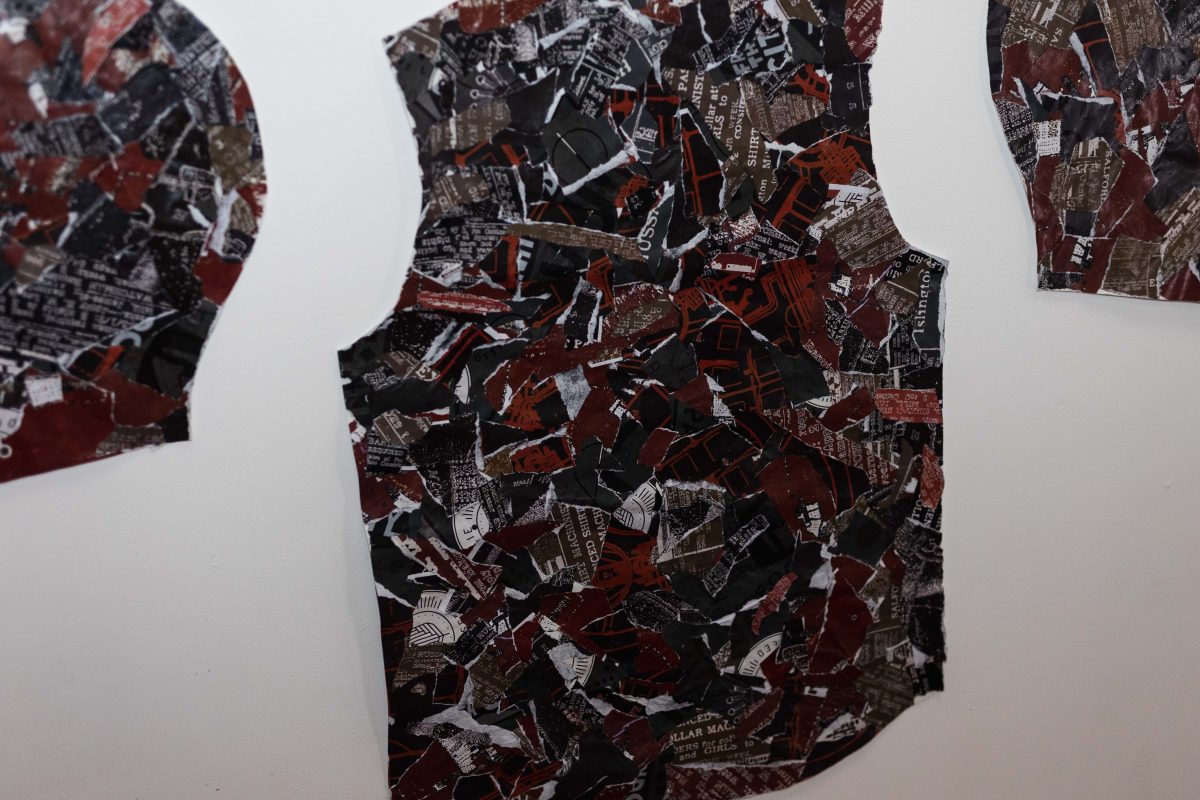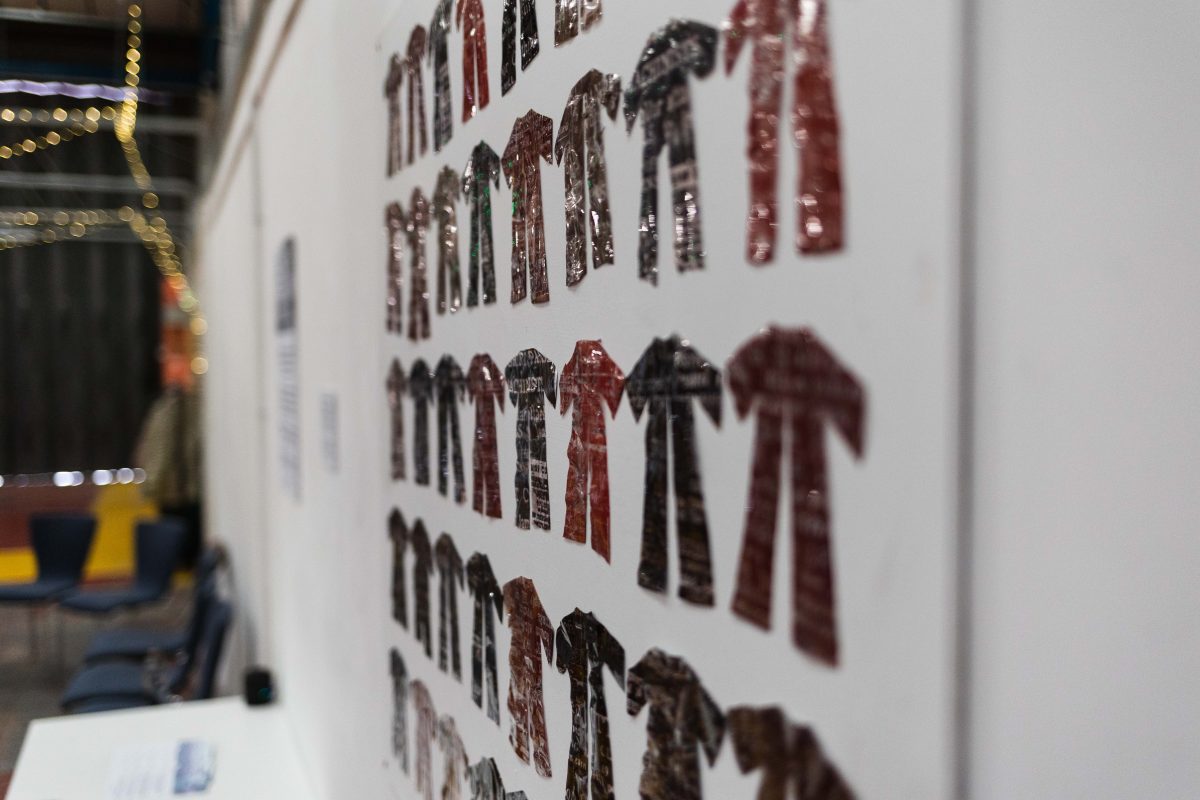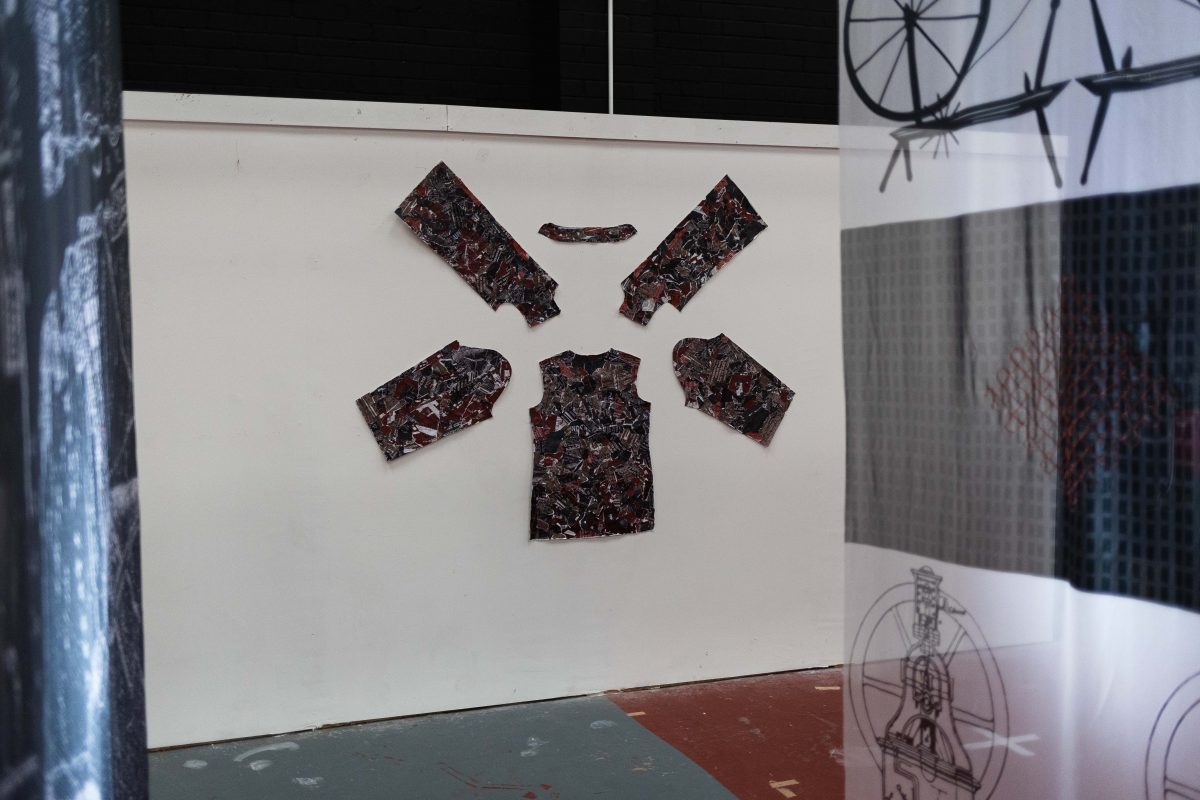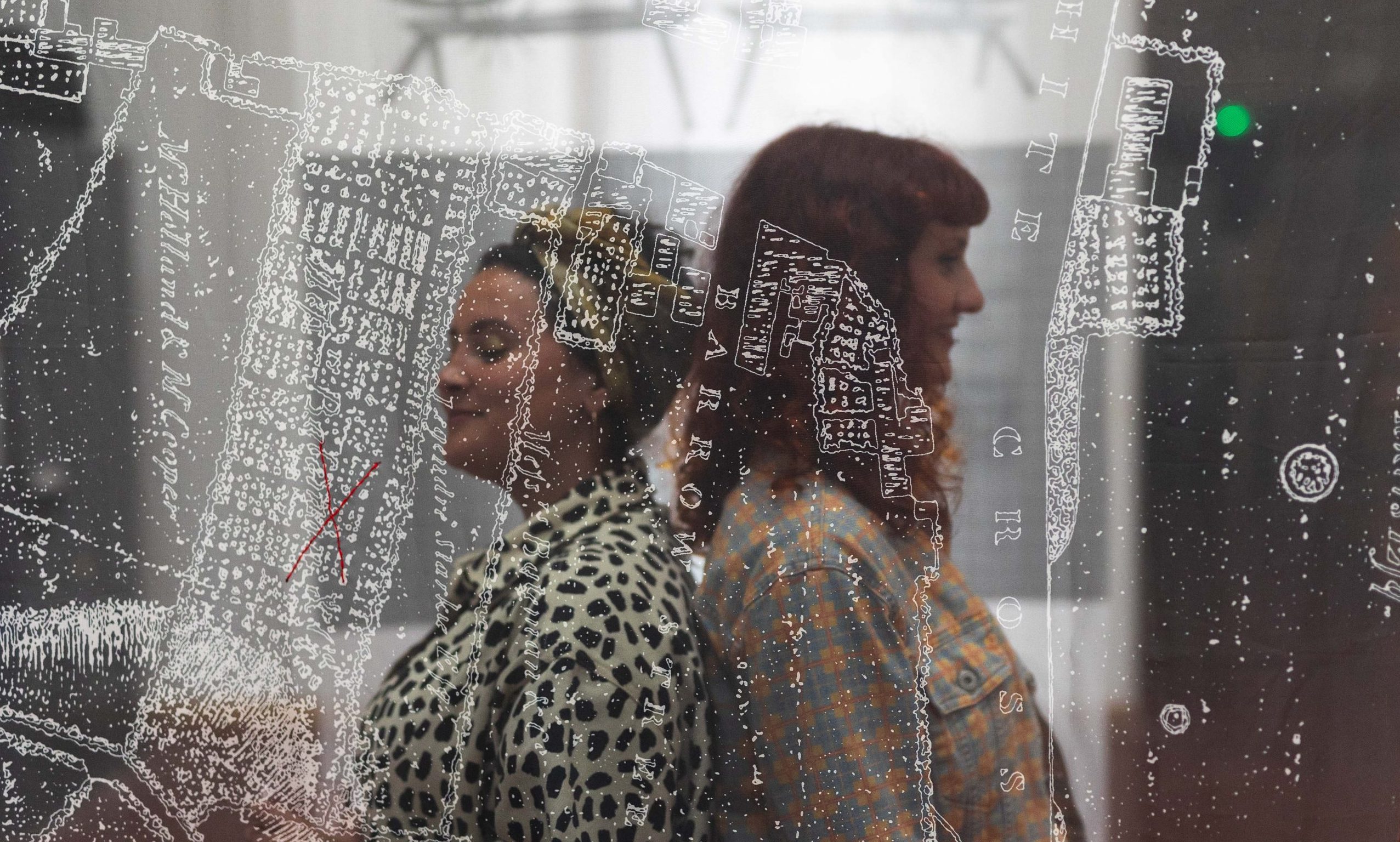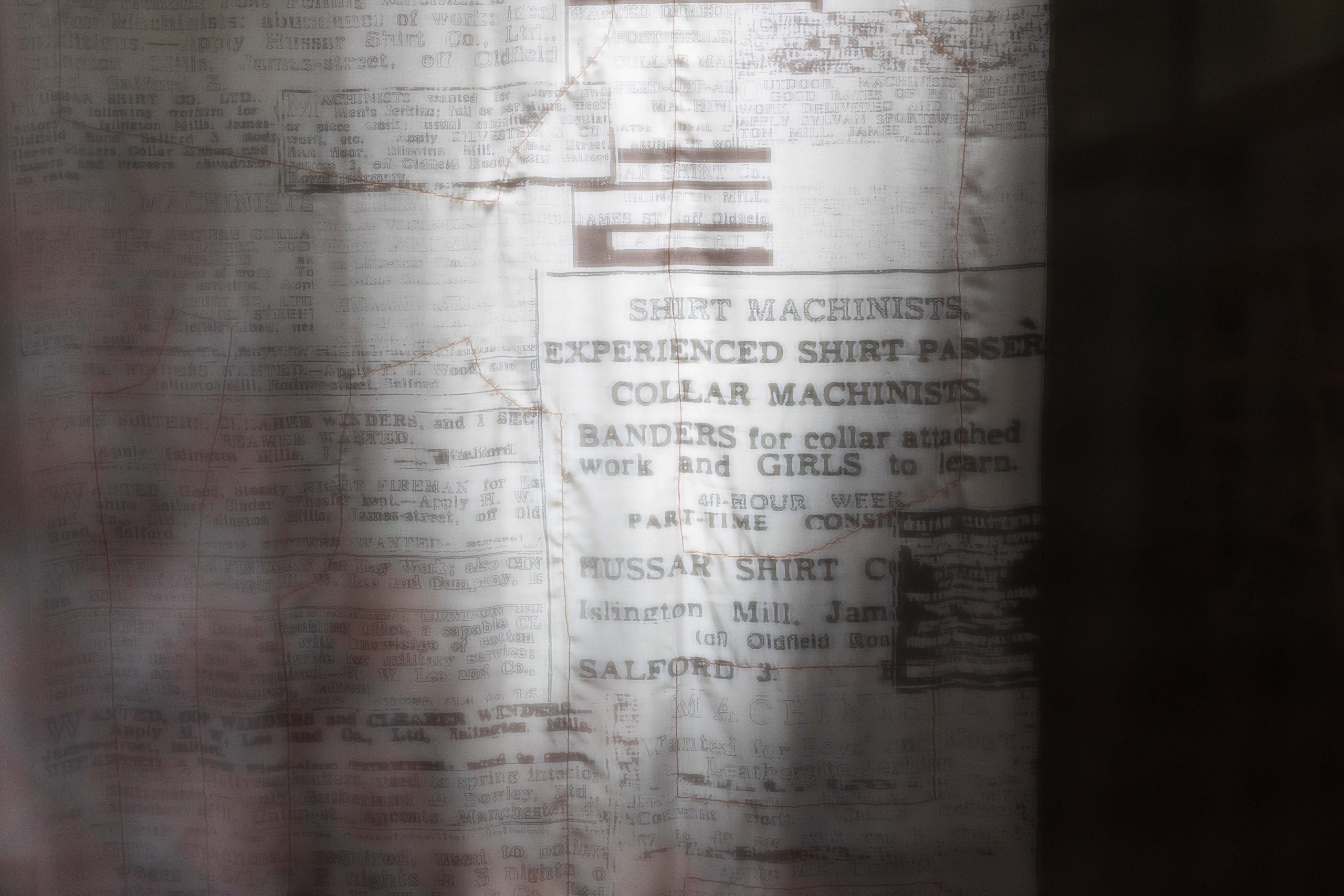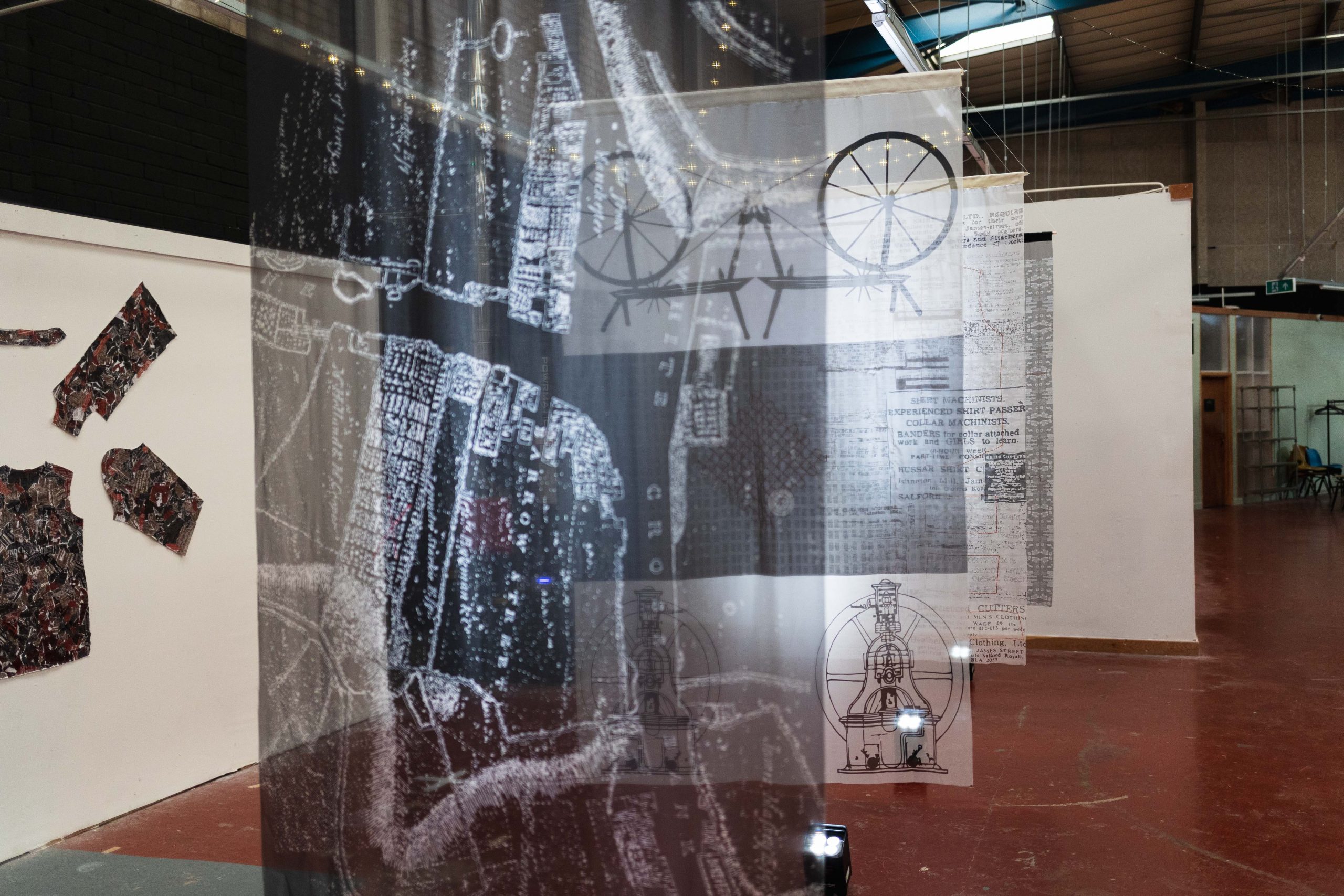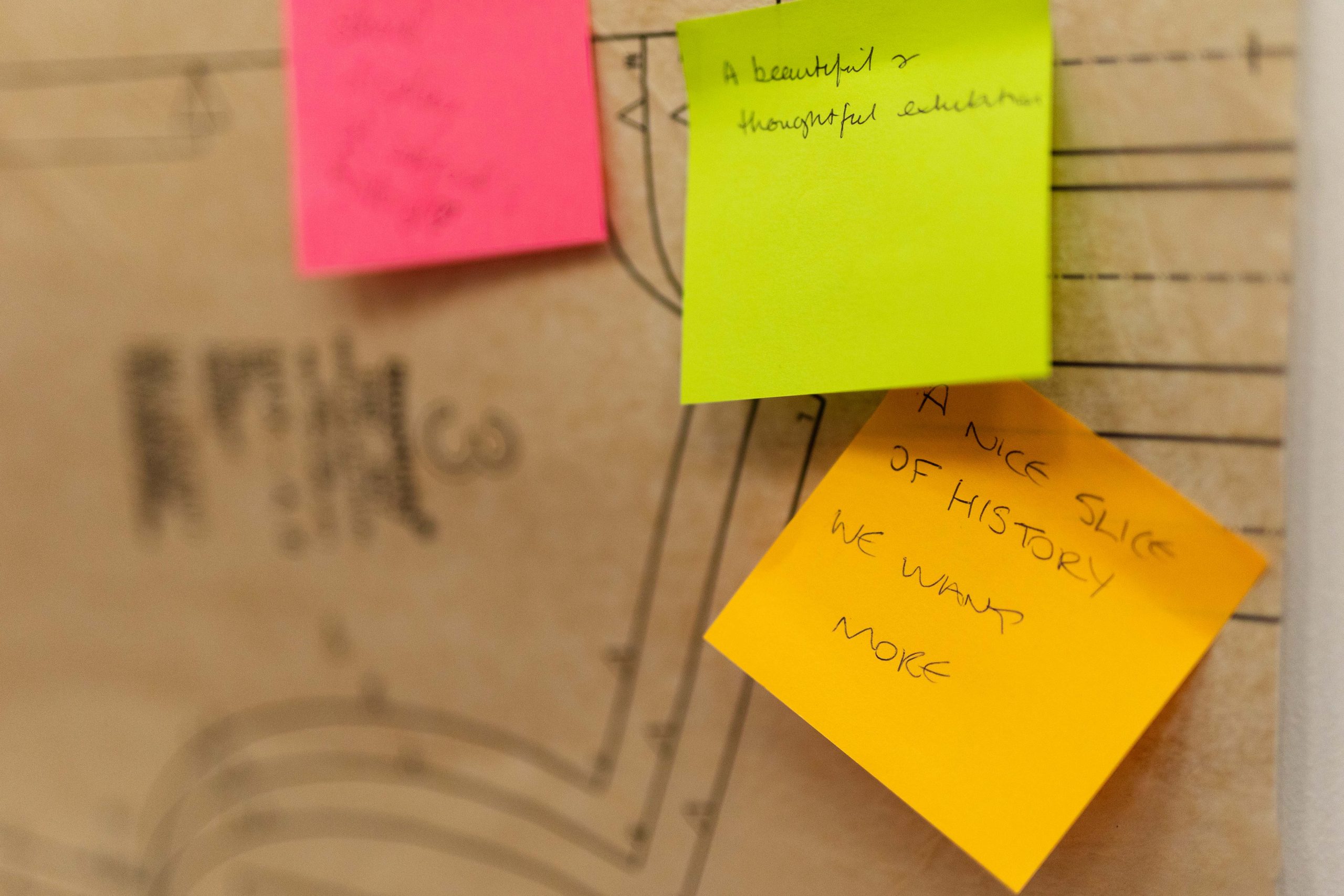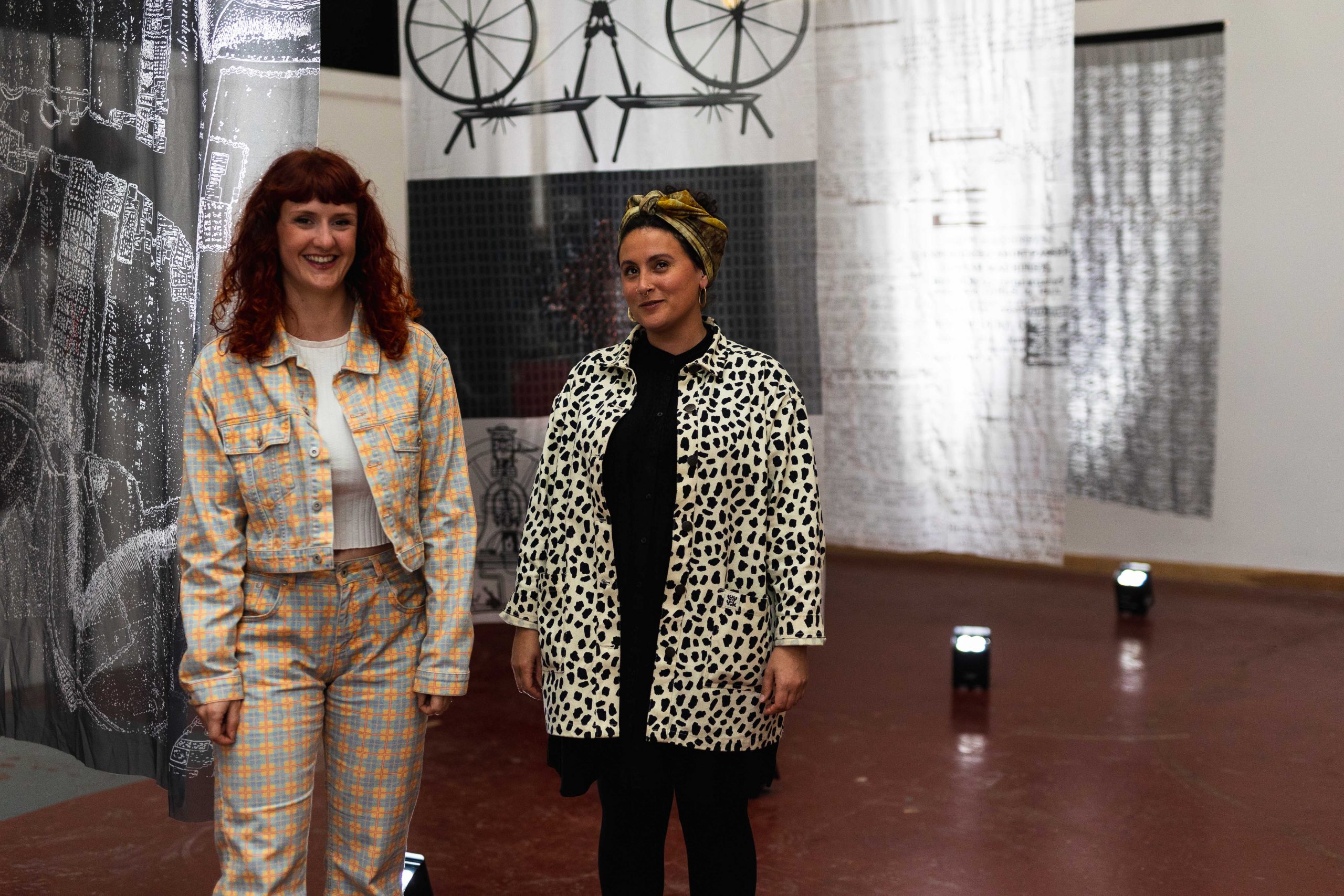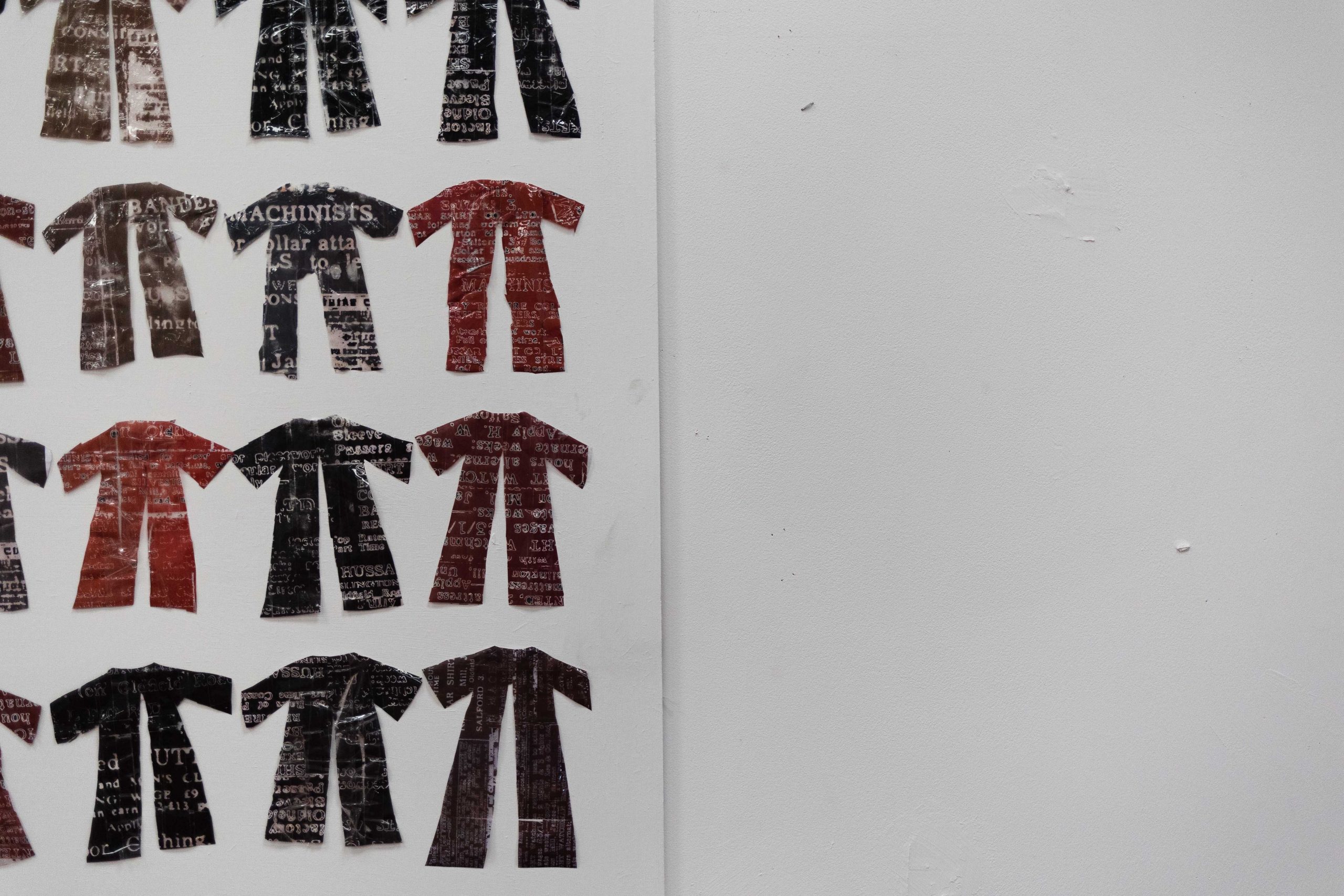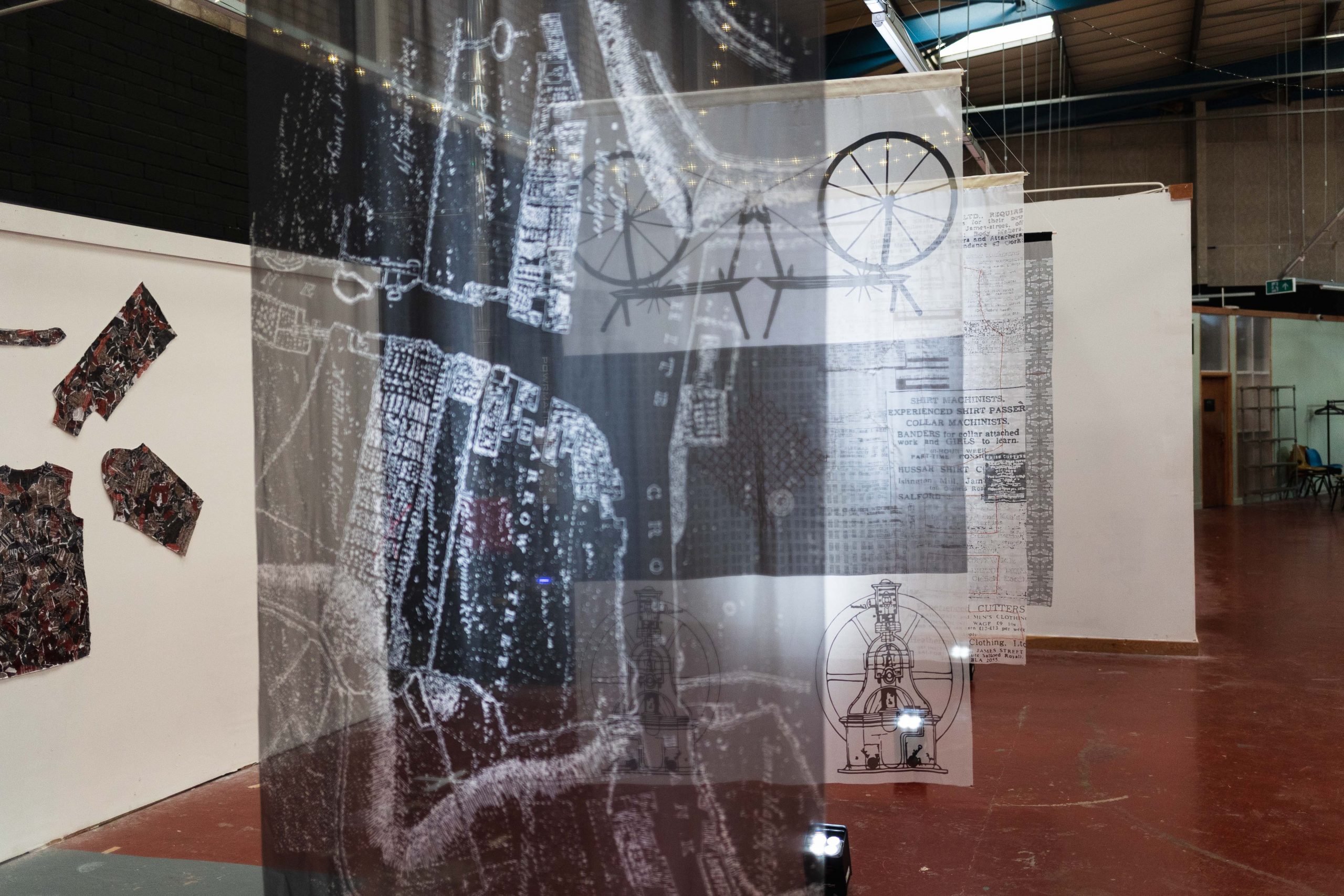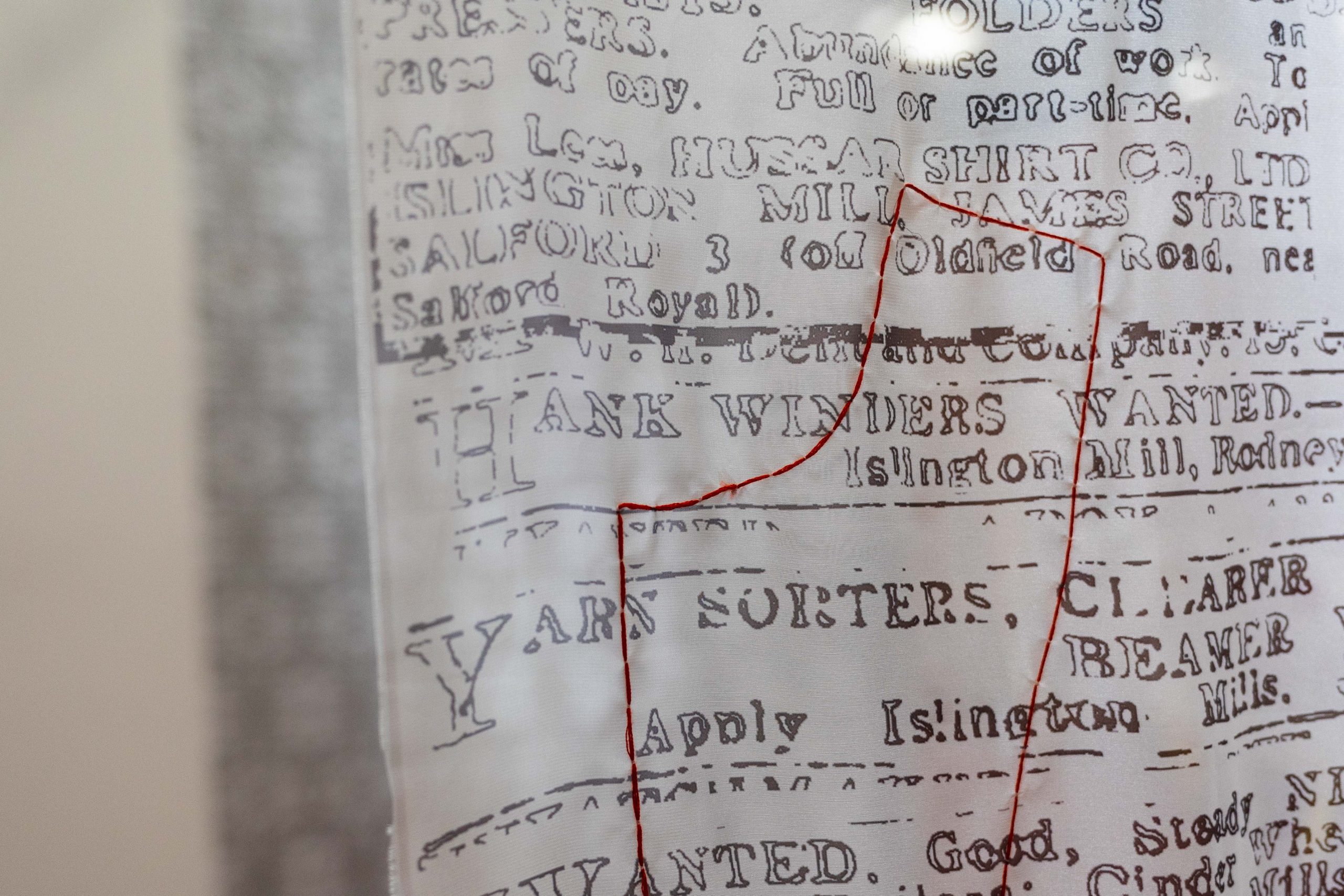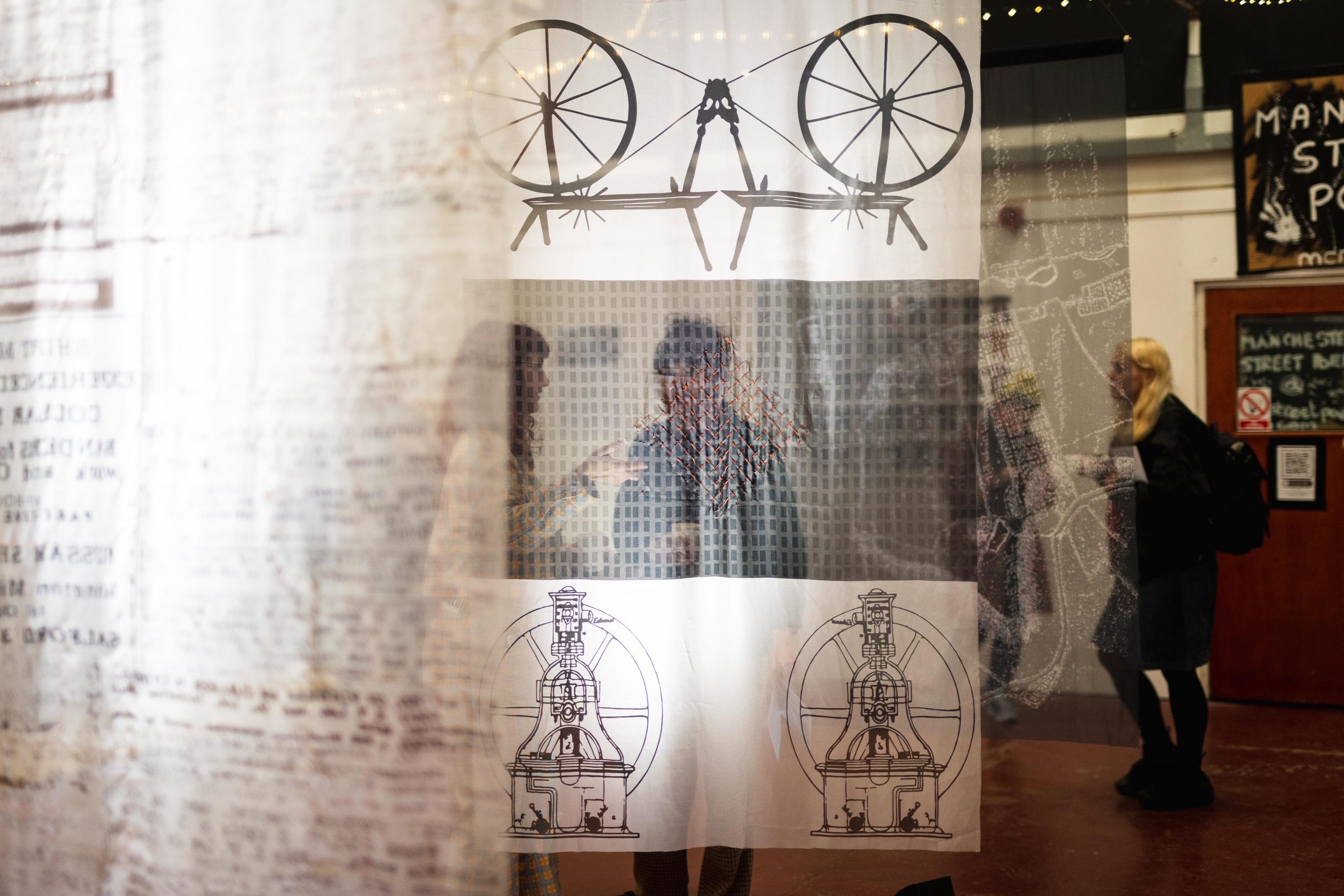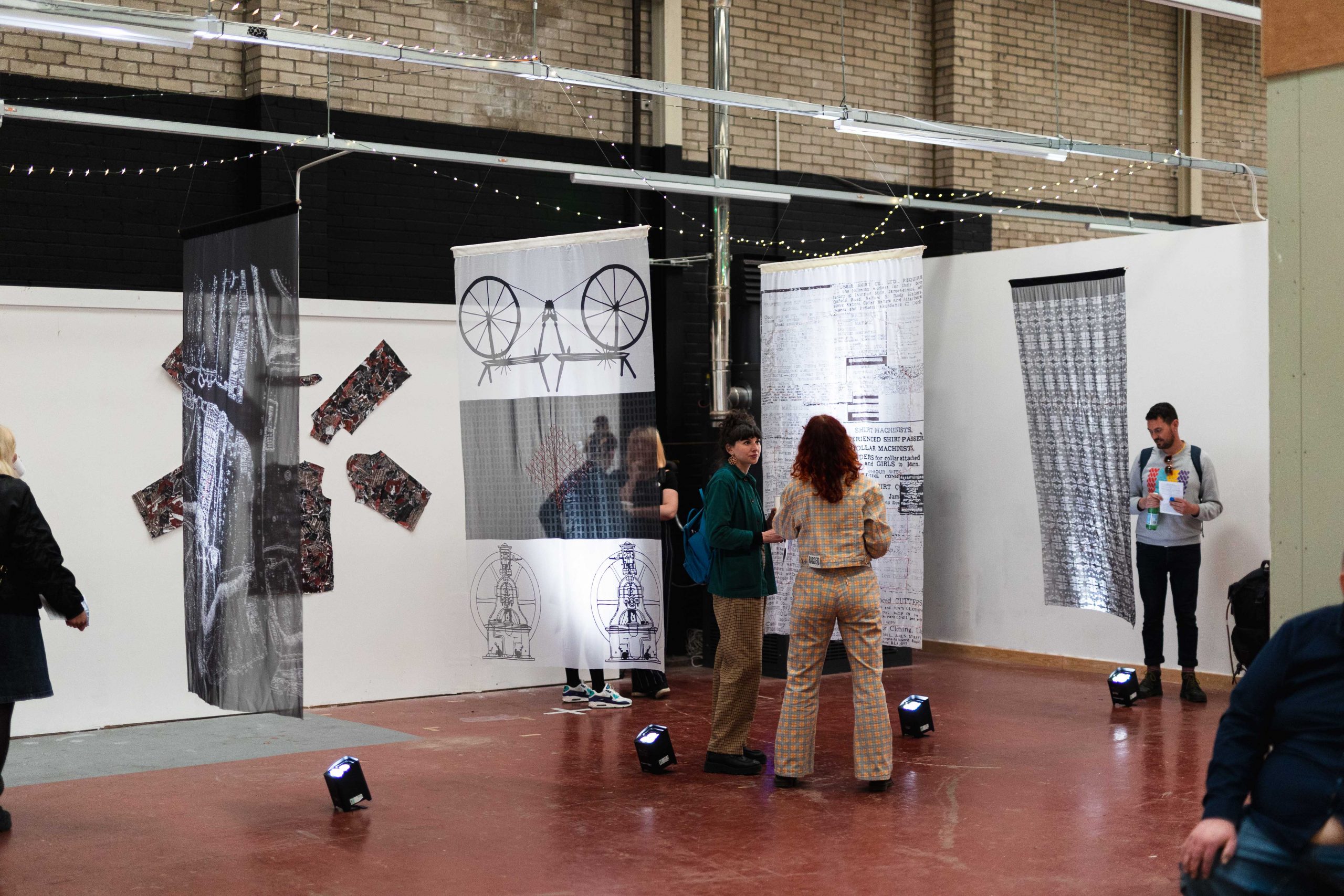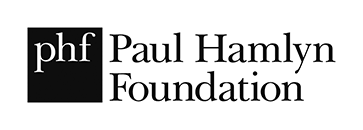All photographs taken by Joe Smith.
Introduction
‘Room and Power’ is the name given to one of our artist-led heritage projects in which textile artists Natalie Linney and Jessie Stringer-Fewtrill worked with historical researcher Mark Charnley to look in detail at some of the previous occupants of Islington Mill. New art works were then created and exhibited out of this research which helped audiences engage with and reflect upon the long and intertwined histories of our mill.
The lead artists also collaborated with Year 5 and 6 pupils from our fantastic neighbourhood school, St Philip’s CE Primary. The children produced their own artworks referencing the heritage of Islington Mill and we were thrilled to then welcome the pupils to visit the full show and see their work on the walls of the gallery space. Their conversations, ideas and enthusiasm was a project highlight.
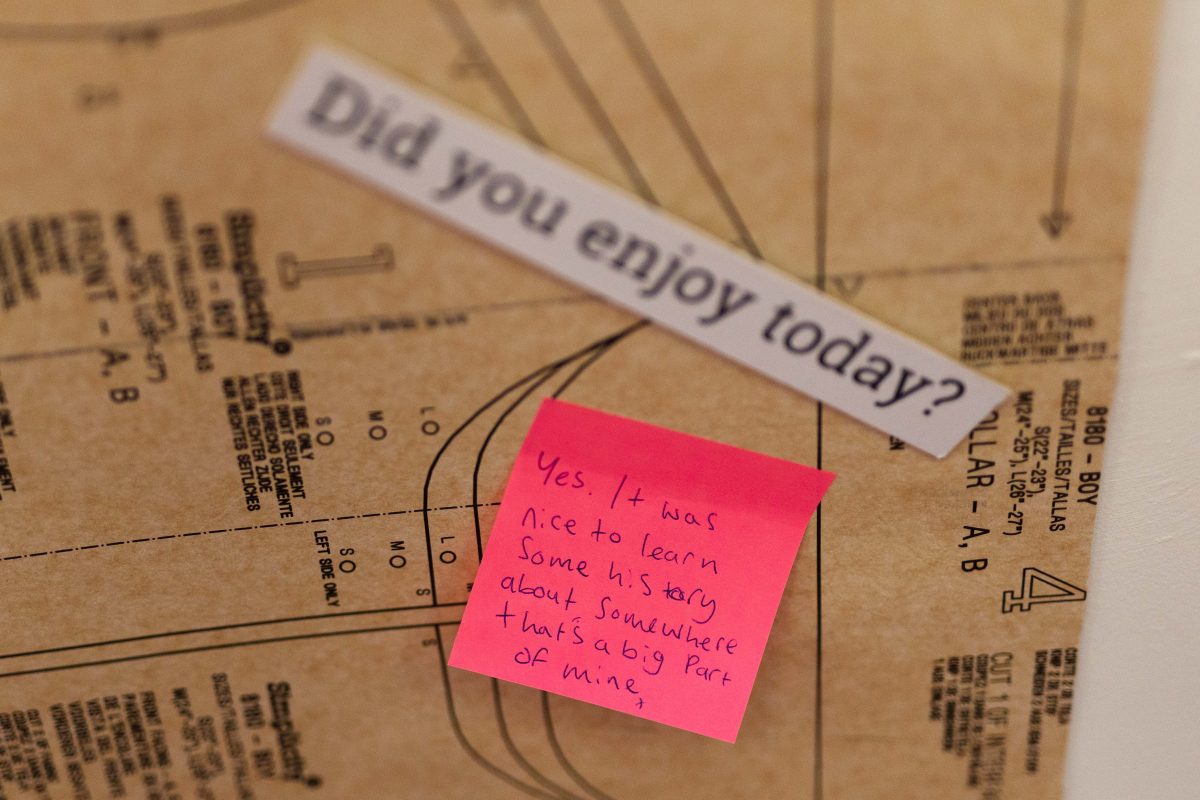
Room and Power?
Islington Mill is an excellent example of a Lancashire ‘room and power’ mill. In these types of mills, business owners would pay rent to the building owner to occupy a room at the mill, plus access to the building’s power supply. Islington Mill was powered by the engine house that once occupied part of the ground floor, before later being moved to its own outhouse on the courtyard. Evidence of power supply cables can still be seen in various grooves inside our building.
Exploring the mill’s occupants
The ‘Room and Power’ project focused on the history of occupation and collaboration at Islington Mill through the creation and exhibition of artistic responses to detailed social research. For 200 years Islington Mill has been a hub of industry, making, design and entrepreneurship. From cotton to raincoats, steam engines to M3 Industries, Islington Mill’s industrial heritage tells the story of the people who worked here and the place that shaped them.
The new artworks
Fabric 1
This print features a map of the local Salford area before Islington Mill was built. A stitched red cross marks the place where Islington Mill stands today.
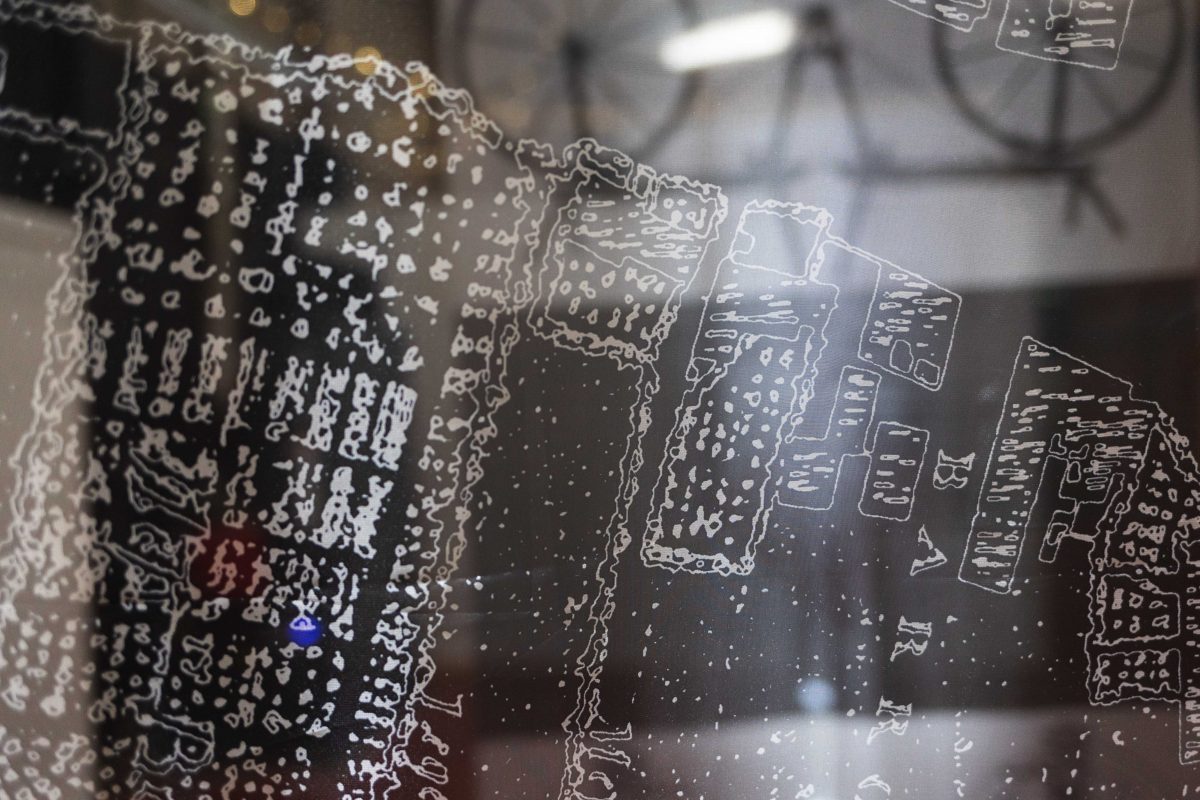
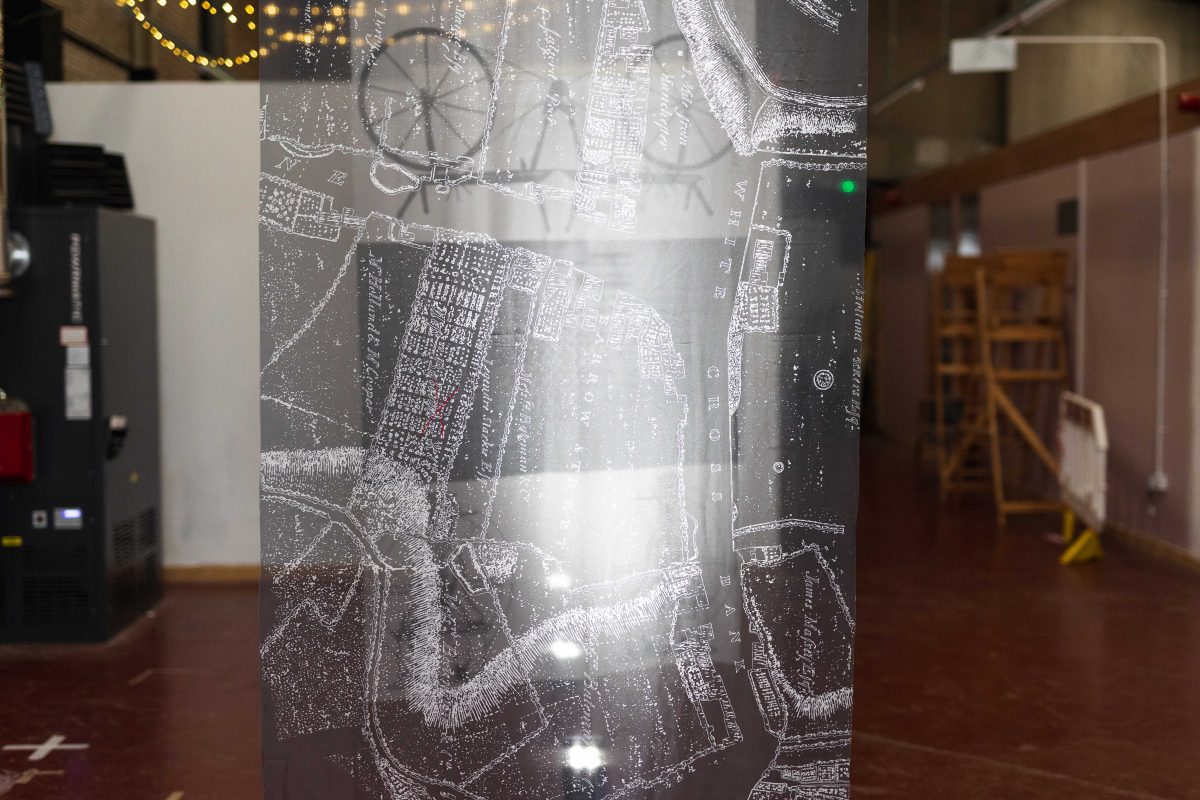
Fabric 2
Spinning wheels
The cotton spinning wheels featured at the top of this piece represent the opening of Islington Mill in 1823. The mill was originally dedicated to cotton spinning, and was designed and built for this purpose by the Leeds-born architect David Bellhouse (1764–1840), who was commissioned by the industrialist Nathan Gough.
Islington Mill was one of the earliest mill buildings in the wave of factory and mill construction that was central to the Industrial Revolution in Manchester. The 19th century saw great upheavals in work and home life, urban living, industrial innovation on a grand scale, with concomitant human exploitation and hardship.
Nathan Gough came from a large working class family in Holt Town, a factory colony in East Manchester. From the age of ten he worked at his brother’s cotton mill, eventually rising to the rank of manager at age seventeen. He was self-educated and eventually ran his own factories.
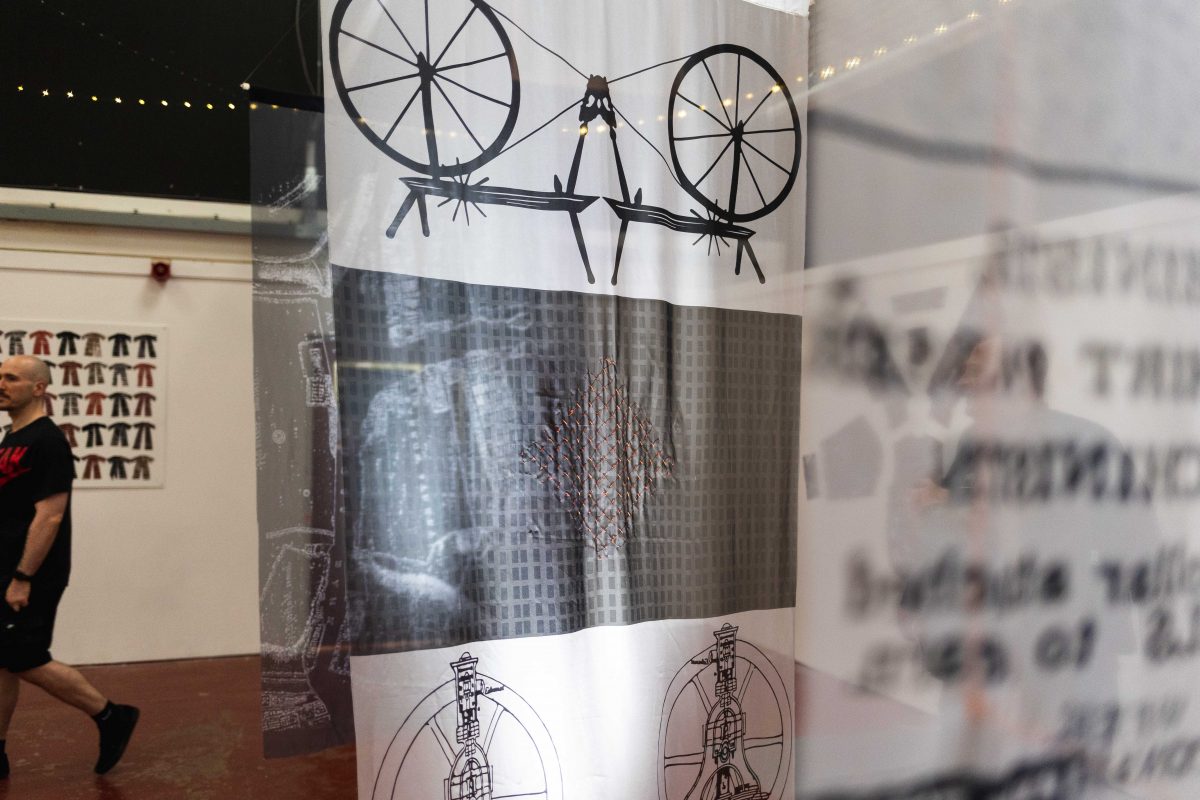
Steam engines
In 1829 Nathan Gough moved away from traditional cotton spinning and took on a new venture in mechanical engineering. He began to design & manufacture steam engines, some of the very first of their kind. This created Islington Mill’s first transition and showed Nathan Gough’s ability to adapt to an ever-changing economy through technology. The images at the bottom of this piece are taken from some of the designs produced by Nathan Gough.
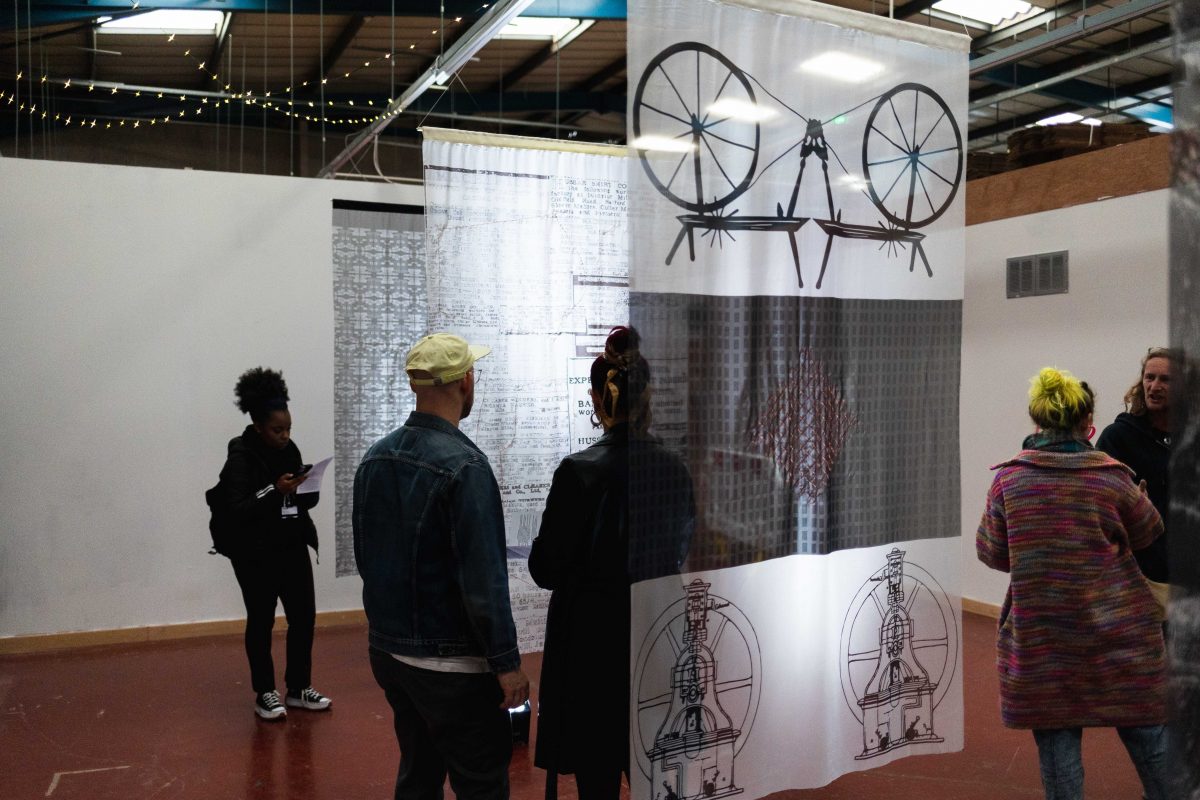
Inside the mills, workers as young as nine years old would arrive on foot from the surrounding cramped cottages and pitiful slums to enter into the gloomy factory at dawn and work for a solid hour on an empty stomach before taking breakfast and resuming work, in shifts that could last up to eleven hours in total. Nathan Gough would later suggest that anything less than sixty-nine hours a week should be considered “detrimental to trade.”
The Weavers Union
Factory and mill workers in this era enjoyed little protection in terms of age restrictions for workers, duration of working hours, fair wages and sick pay, or health and safety for working with dangerous machinery. Machine malfunctions, construction and debt issues caused many to lose jobs, become injured and even lose their lives, but a sense of community was strong, perhaps engendered by these very conditions. It was down to working people themselves to force change and workers of Islington Mill seemed to have been active in this area.
Records show that workers at Islington Mill made donations to their local hospital and to the Peel Park Memorial. In 1842, mill workers also supported the establishment of a Weavers Union, uniting workers to better their conditions and their community. Change did come, for example in 1844 laws were made guaranteeing safer factory machinery. The symbol for the Weavers Union is stitched into the centre of Fabric 2.
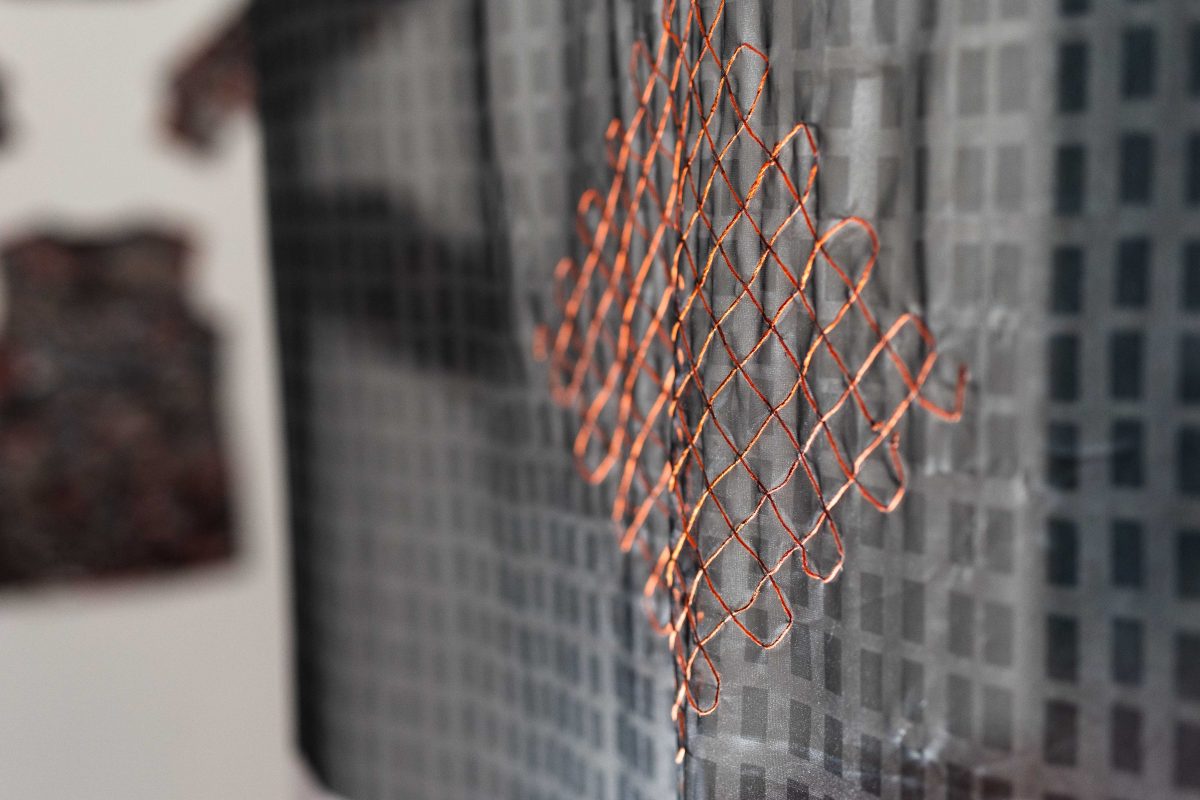
1000 dashes
At the height of the Industrial Revolution in the mid 19th century, fortunes could be made and lost in a matter of a few years. After a prosperous period in Islington Mill’s history we see that in 1850 the mill fell into debt under the mismanagement of W. Morris due to defaults on mortgage payments. This saw thousands of workers lose their jobs and all the factory machinery sold off at auction.
In the centre of Fabric 2 we added a thousand dashes to represent these abandoned workers. The dashes have been positioned in such a way as to look like the windows of a large mill, dramatising the link between the people who worked at the mill and the building itself. Mills often employed people from the same family, with fathers, mothers and children all working together at the same machines. An event like this would have had a huge impact on the community. With so many hands newly out of work it would have been very difficult to pick up new employment elsewhere with competition already being very high. Hardship no doubt followed.
Fabric 3
20th Century
During this century, Islington Mill evolved from fabric making to garment construction to wholesaling items, particularly from Germany. This evolution accurately reflects the broader industrial changes that occurred over these years. By the 20th century clothing manufacture had taken over from fabric manufacturing and Islington Mill was once again transformed to meet the new demands of the economic climate.
As fabrics were being woven in India and Pakistan, many mills sold their equipment to companies overseas who used cheap labour to produce textiles. This model is still used today and caused a huge transformation in the clothing industry, paving the way for the import / export market.
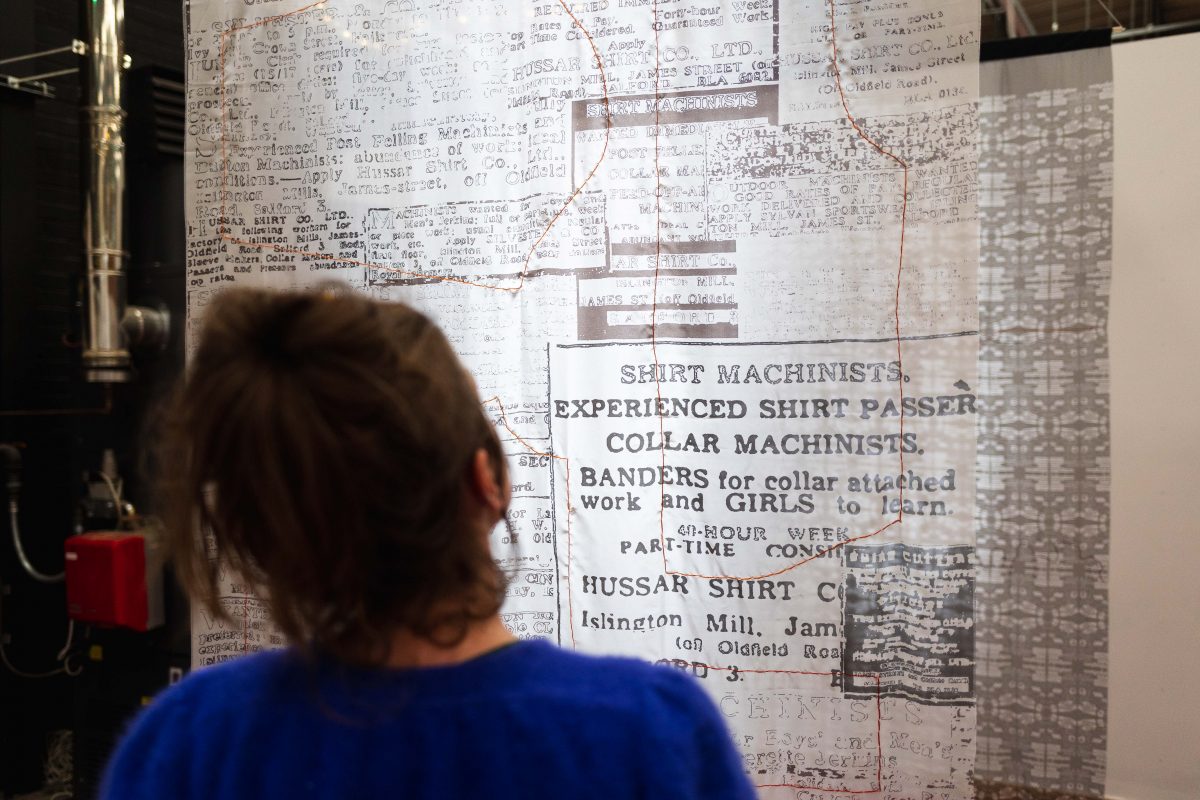
In this era the consumption of clothing hugely increased as fashions were made more affordable. This piece details the newspaper adverts from the companies that operated from Islington Mill during the 20th century. Embroidered over the print are the sewing pattern pieces for a man’s shirt, which was the main item being produced at the mill at this time.
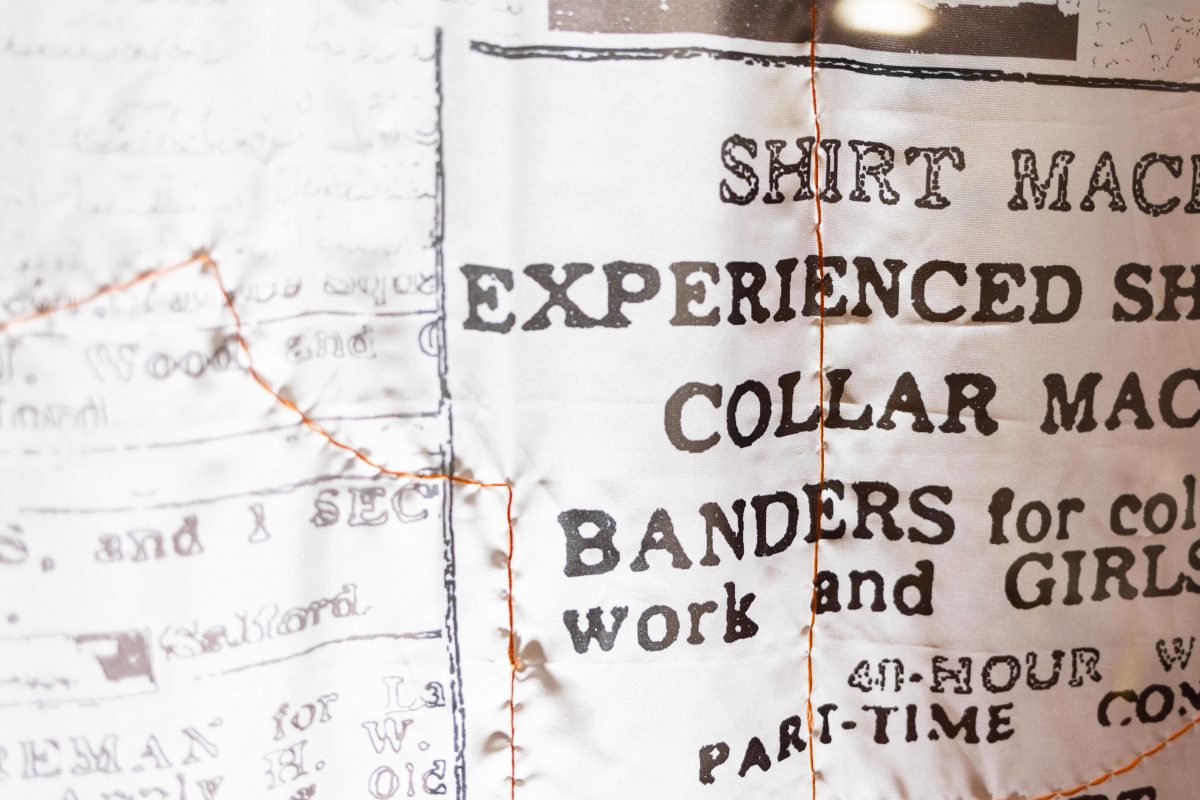
Fabric 4
21st Century
Throughout the mill’s history up until current times the building has always been filled with people sharing space in which to create. This final piece pays homage to some of the current residents at Islington Mill whose logos have been combined to create an original pattern design. Embroidered onto the fabric are two crowd scenes from The Burrow, the club that used to be housed here at the Mill, plus a sound wave taken from ‘Bad Apple’ from the band GNOD, who played there many times.
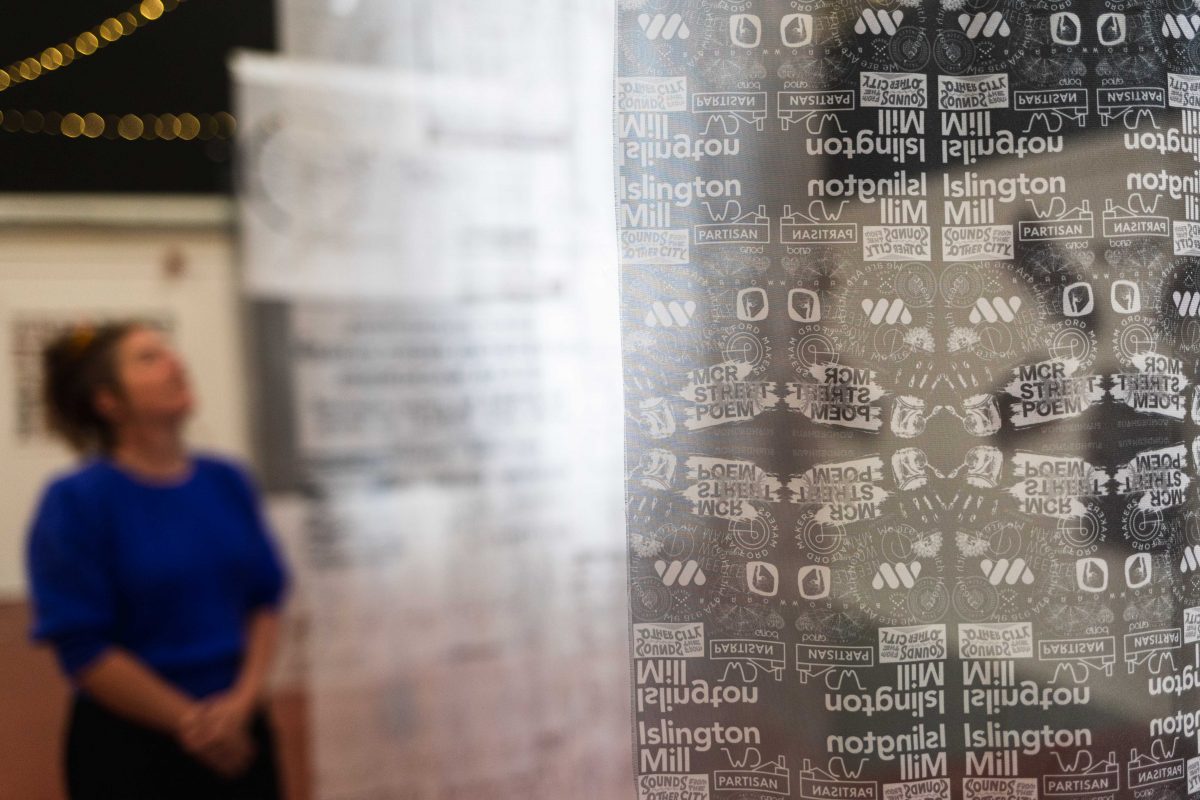
The busy interconnected pattern was created to show the varied and bustling environment that we have at the Mill. Although we may not all know each other we are all connected and share a commonality in our love of our space and the community we have built here. The mill provides a safe place that is home from home for many people. There are painters, musicians, small businesses, performers, educators, drag artists, curators, writers, and many artists working in every conceivable medium from video to textile, performance to clay, and beyond. The connectivity between us enables us to collaborate and draw on each other’s specialisms for ideas and projects, allowing us to push our work further.
St Philip’s Primary School
St Philip’s Primary School sits just across the road from the Mill on James Street. We were excited to spend a day there with the children of Year 5 and 6 exploring the theme of constructed and deconstructed garments. The young people learned about the people who had worked at Islington Mill in the past, and the different kind of jobs they did. The students made their own mini raincoats inspired by the raincoats that Islington Mill was well known for in the 1960s & 70s.
If you look closely at the coats they have produced you can see that they are made from advertisements for jobs that were available at the mill. With this project, we wanted to create something with the students working together to show that collaboration is still a huge part of our mill culture today. As a full class we made collages containing visual elements from our heritage research. The collages were used to fill shirt and jacket pattern pieces linking back to the production of clothing past and present at Islington Mill.
